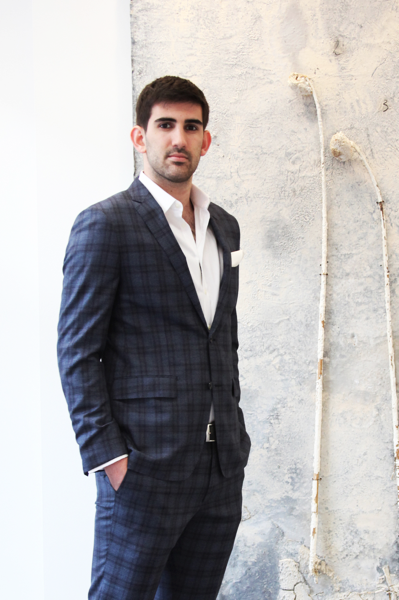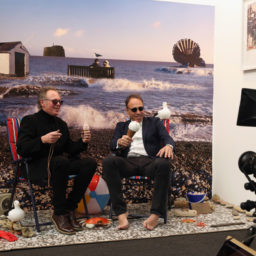

Omer Tiroche has just opened his first space in the heart of London’s Galleryland: Mayfair. And he did in style. The inaugural exhibition, “Redefining Paint: Germany and Austria since 1970s” gathers a slew of heavy-hitters that would make many far more senior dealers envious: Gerhard Richter, Sigmar Polke, Anselm Kiefer, and Franz West, among others.
Art dealing runs in the family. Omer’s father, Micky, has been operating as a private dealer in London since 1996, having previously founded the Tiroche Auction House in Israel. Omer’s uncle, Serge, is a key player in the growing art fund industry, and co-founder of the Tiroche DeLeon collection.
Hot on the heels of Omer Tiroche Contemporary Art’s inauguration, artnet News caught up with the promising scion.
How did the gallery start?
The gallery started by accident in fact. I participated in a relatively small art fair in Basel last June, where I brought several high-value artworks. I expected to sell nothing there; the whole point was to burst onto the scene with a bang. Beyond my wildest expectations, I practically sold out the booth. A few months later, a close family friend (also a London dealer) convinced me that opening a space would not be as difficult as I had initially thought and strongly encouraged me to go for it. It all happened very quickly: I spent only three days looking for a space, traipsing the web for properties and speaking to several agents. I quickly ended up finding this spot during a walking tour of Mayfair, looking for “to let” signs. I saw the space, the building, and the location, and knew it was perfect for me.
You’ve operated as a private dealer for just over two years. Why did you feel the need to open a gallery?
For a while now I have felt that curating shows and playing an active role in the creative direction of exhibitions was something I very much wanted to pursue. Operating as a private dealer, consigning works to other galleries— which is still the most prominent aspect of our business—meant having very little interaction with private collectors and narrowed my creative input. In my youth, I always loved performing on stage, so a backstage role didn’t feel right. In the short period that I have been operating publicly, I have realized that being a gallerist and making a sale is like a mini performance in its own right.
In our hyper-connected era, why is the physical space important?
Despite the figures that Christie’s have released from their online sales, and Sotheby’s recent venture with eBay, I am still not convinced that big sales are fully achievable [online]. There is no substitute to seeing a work of art in the flesh, no matter how high the resolution of an image may be. Art is something to be experienced and ultimately lived with.
How influential was your father in your art education? Is he directly involved in your venture?
While finishing my degree in Art History, I found myself becoming more and more involved with the business side of things. Being the youngest gallery owner in Mayfair is a fun title to have, but having the support of someone with almost 40 years of experience is absolutely invaluable. Although I only started participating in the purchasing when I joined on two years ago, our stock goes back much further. Since all the works I exhibit in the gallery and in art fairs come from our inventory, saying that he is involved in the venture is something of an understatement. Despite his initial reluctance to “go public,” he was very pleased when the healthy sales started coming. Now the talk around town is all about Micky’s radiant pride in Omer’s new gallery.
Your first exhibition features a slew of household names. Do you intend to primarily focus on the secondary market?
I feel that at this stage in my career it is wise to start off within my comfort zone, and these artists definitely fall in that category. My true passion lies with Post-War and Contemporary art from Europe and America but, that being said, my next show in May will feature an array of young Korean artists, many of whom have never hit the auction block or had gallery representation. In the meantime, I’m enjoying being able to keep an open mind and take decisions as they come, as opposed to choosing a path now and having to stick to it. We are constantly looking into new artists and markets to buy into, and I can’t see that stopping anytime soon.
How would you define the gallery’s ethos?
I won’t give the cliché of “fresh, vibrant, and cool” because that’s not where I see myself situating the gallery—it’s still Mayfair after all. However, I do intend to bring a younger edge to the area’s first floor galleries, while still upholding the integrity that is becoming of W1.
What are the main challenges for a young gallery like yours?
The challenges are twofold: the first is the daunting task of building a solid client-base, and the other is being overlooked by art fair selection committees. The caliber of stock that I have targets true collectors in the market and sits in line with, and sometimes above, many galleries who exhibit at the best art fairs in the world. However, the reality is that having only recently entered the gallery scene, not everybody is aware of the strength of what I have to offer.
Follow Artnet News on Facebook:
Want to stay ahead of the art world? Subscribe to our newsletter to get the breaking news, eye-opening interviews, and incisive critical takes that drive the conversation forward.






